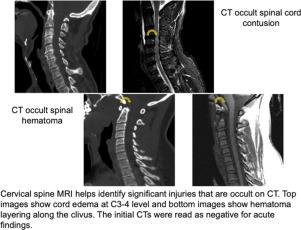Journal of Neuroradiology ( IF 3.0 ) Pub Date : 2019-05-24 , DOI: 10.1016/j.neurad.2019.05.001 Keita Onoue 1 , Chad Farris 1 , Hannah Burley 1 , Edward Sung 1 , Mariza Clement 1 , Mohamad Abdalkader 1 , Asim Mian 1

|
Background and purpose
Cervical spine injury is common in the setting of blunt trauma and there is consensus that cervical spine CT (CSCT) is the image modality of choice for initial evaluation for blunt trauma related injuries of the cervical spine. However, there is disagreement in the literature with regards to further evaluation of blunt trauma patients with cervical spine MRI (CSMRI) after negative CSCT when there is persistent clinical concern for occult trauma related injury. The purpose of this study is to examine the utility of CSMRI for detection of occult injury in blunt trauma patients after negative CSCT.
Materials and methods
We reviewed records for 7,301 patients admitted for blunt trauma (November 2007–December 2013) and identified 259 who underwent CSMRI after a negative CSCT. These CSMRIs were reviewed to determine the number and type of significant CT occult injuries identified and clinical indications that led to CSMRI acquisition.
Results and conclusions
CSMRI detected significant injuries following negative CSCT in 31% (81/259) of patients. There were 15 cord contusions/infarcts, 9 bone contusions/fractures, 7 spinal canal hemorrhages and 66 soft tissue injuries. Upper extremity neurological deficit had greatest positive predictive value (PPV) for detection of CT-occult injury on CSMRI of 43% (23/53), followed by equivocal CSCT findings (38%, 18/47), presence of extra-cervical injuries (34%, 20/58), midline cervical tenderness (20%, 17/85), and isolated lower extremity neurological deficit (0%, 0/16). CSMRI is recommended following negative CSCT in the evaluation of blunt cervical spine trauma when appropriate clinical concerns are present.
中文翻译:

颈椎 MRI 在钝性创伤中颈椎 CT 阴性背景中的作用:提示隐匿性损伤的临床发现中的关键附加信息
背景和目的
颈椎损伤在钝器伤的情况下很常见,人们一致认为颈椎 CT (CSCT) 是颈椎钝器伤相关损伤初步评估的首选图像模式。然而,当临床持续关注隐匿性创伤相关损伤时,关于在阴性 CSCT 后进一步评估钝性创伤患者的文献存在分歧。本研究的目的是检查 CSMRI 在检测阴性 CSCT 后钝性创伤患者的隐匿性损伤中的效用。
材料和方法
我们审查了 7,301 名因钝器伤入院的患者(2007 年 11 月至 2013 年 12 月)的记录,并确定了 259 名在 CSCT 阴性后接受 CSMRI 的患者。审查这些 CSMRI 以确定已识别的显着 CT 隐匿性损伤的数量和类型以及导致 CSMRI 采集的临床适应症。
结果和结论
31% (81/259) 的患者在 CSCT 阴性后 CSMRI 检测到显着损伤。脊髓挫伤/梗塞15例,骨挫伤/骨折9例,椎管出血7例,软组织损伤66例。上肢神经功能缺损在 CSMRI 上检测 CT 隐匿性损伤的最大阳性预测值 (PPV) 为 43% (23/53),其次是不明确的 CSCT 结果 (38%, 18/47),存在宫颈外损伤(34%, 20/58)、中线颈部压痛 (20%, 17/85) 和孤立的下肢神经功能缺损 (0%, 0/16)。当存在适当的临床问题时,建议在 CSCT 阴性后评估钝性颈椎创伤时使用 CSMRI。











































 京公网安备 11010802027423号
京公网安备 11010802027423号